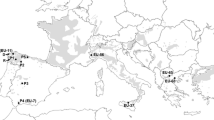Summary
Five cycles of divergent mass selection for crown height in sugar beets gave average gains of 11.3% to 24.1% per cycle. Realised heritabilities were about 0.4. This progress from mass selection was obtained by paying special attention to soil uniformity, seedbed preparation and sowing, regular stands with plant distances of 50 cm, selection per plot, checking of the measurements, equal representation of seed parents in the next generation, reasonable population sizes and flexible selection intensities.
Comparing the data of the generations grown in different seasons with the data of the same generations in one growing season resulted in very high correlation coefficients. It is concluded that mass selection can still be a powerful method of intrapopulation improvement.
Similar content being viewed by others
References
BeckerW. A., 1975. Manual of quantitative genetics. 3rd Ed. Washington State University, Pullman, Washington, USA.
BornscheuerE., 1972a. Ursachen der Herauswachsens der Zuckerrüben aus dem Boden. Zuckerrübe 21: 26–28.
BornscheuerE., 1972b. Fortschritte und Aussichten bei den Züchtung von Zuckerrüben. Mitt. DLG 14: 344–346.
BosI., 1981. The relative efficiency of honeycomb selection and other procedures for mass selection in winterrye (Secale cereale L.). Agric. Univ., Dept. of Plant Breeding, Wageningen; 172 pp.
Burton, G. W., 1975. Recurrent restricted phenotypic selection to increase forage yields. Proc. 23rd Grass Br. Work Plan. Conf., St. Paul, Minnesota, p. 45–47.
BurtonG. W., 1982. Improved recurrent restricted phenotypic selection increases bahiagrass forage yields. Crop Sci. 22: 1058–1061.
CorstenL. C. A., 1970. Wiskundige statistiek. Syllabus Kandidaatscollege, Landbouwhogeschool, Wageningen.
Empig, L. T., C. O.Gardner & W. A.Compton, 1972. Theoretical gains for different population improvement procedures. Nebr. Agr. Exp. Sta. No. MP26, revised.
FalconerD. S., 1964. Introduction to quantitative genetics. Oliver and Boyd, Edinburgh and London.
Fasoulas, A., 1981. Principles and methods of plant breeding. Arist. Univ., Thessaloniki, Publ. No. 11. 147 pp.
GardnerC. O., 1961. An evaluation of effects of mass selection and seed irradiation with thermal neutrons on yield of corn. Crop Sci. 1: 241–245.
Gardner, C. O., 1969. The role of mass selection and mutagenic treatment in modern corn breeding. Proc. 24th Ann. Corn and Sorghum Res. Conf., p. 15–21.
HallauerA. R. & J. B.Miranda, 1981. Quantitative genetics in maize breeding. Iowa State University Press, Ames.
JorritsmaJ. & J. F. T.Oldfield, 1969. Effect of sugar beet cultivation and extent of topping on processing value. Journ. IIRB: 3: 226–240.
LonnquistJ. H., 1964. A modification of the ear-to-row procedure for the improvement of maize populations. Crop Sci. 4: 227–228.
LeCochecF., 1972. Données récentes sur la méthode de sélection massale. Ann. Amélior. Plantes 22: 389–397.
PetersonD. F. & C. E.Cormany, 1961. Use of unit block selection method for yield, sugar and purity in sugar beets. J.A.S.S.B.T. 11: 323–326.
PoehlmanJ. M., 1979. Breeding field crops. Henry Holt and Company, Inc., New York. 2nd Edition.
SchafmayerH., 1969. Richtige Höhe des Köpfschnittes bei der Ernte von Zuckerrüben. Die Zuckerrübe 18: 8–11.
SnedecorG. W. & W. G.Cochran, 1967. Statistical methods. The Iowa State University Press, Ames, Iowa, USA.
SokalR. R. & F. J.Rohlf, 1969. Biometry. W. H. Freeman and Company, San Francisco.
WinnerC. & I.Feyerabend, 1970. Ein Beitrag zur Morphologie und technischen Qualität des Rübenkopfes. I. Grösse und Form des oberirdischen Teils der Rübe. Zucker 23: 500–504.
Wolff, de, F., 1972. Mass selection in maize composites by means of selection indices. Meded. Landbouwhogeschool 72–1; 80 pp.
Author information
Authors and Affiliations
Rights and permissions
About this article
Cite this article
Mesken, M. Mass selection for crown height in sugar beets (Beta vulgaris L.). 1. Divergent selection in diploids. Euphytica 36, 129–145 (1987). https://doi.org/10.1007/BF00730656
Received:
Issue Date:
DOI: https://doi.org/10.1007/BF00730656




